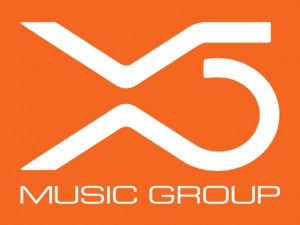The Secrets of Digital Music Sales Success: How X5 Music Excels
MIDTOWN, MANHATTAN: How much of your business model is habitual? If you could start from scratch, what would you keep – and what would you throw away?
When the digital label X5 Music Group started in 2003, its founders had the chance to rewrite every bad old rule of the music business. They took full advantage of the opportunity, and the benefits of a fresh start are clear to see: Today, X5 stands as the world’s highest-selling classical music label by generating over $10 million in sales 2010, with 13 of its albums placing on Billboard’s 2010 year-end Classical Albums chart and a #1 that was parked on iTunes’ Classical chart for over a year.
Originating in Stockholm, Sweden, X5 made two shrewd moves this year: They chose New York City as the home of their U.S. offices, and they recruited former Amazon senior digital music manager Scott Ambrose Reilly to lead it. With his deep background in music management and digital distribution – he was an exec for digital music pioneers Digital Club Network and eMusic before joining Amazon – Reilly knows innovation when he sees it.
Last week’s X5 release, The Greatest Video Games Music, is the latest indication that Ambrose’s instincts were on when he joined the label. A concept album of the best-known video game themes performed by the London Philharmonic Orchestra, the collection was released on Tuesday, November 8 and went directly to #1 on Amazon’s digital download charts.
Ambrose notes that X5’s baggage-free birth had everything to do with why the company is cleanly beating out traditional record labels – and a lot of other digital-only plays as well – in today’s marketplace. “Think about three guys sitting down in 2003 starting out fresh with a record label,” says Reilly, perched 75 floors above NYC from X5’s Empire State Building offices. “You’re going to do it digital-only. You have no legacy catalog and no past history curves to worry about.
“Starting out fresh, X5 didn’t really know how the traditional — what I call the ‘vinyl LP’ business model – worked. That’s what we’ve been living under, and even the way the digital business is run is a variation on that. When you’re not burdened by all that, the future looks great.
“You can say, ‘Why do we have to deliver the exact same product to every retailer? Why do things always come out on Tuesday?’ When you start thinking like that, you start innovating, because you’re not locked into the way things are.”
Applying New Thinking
X5’s inventory is built up not by A&Ring the artists with the most YouTubeviews, but rather by licensing and acquiring musical catalogs, and then optimizing them for individual digital vendors, mobile operators, and mobile handset manufacturers. The resulting releases are compilations that gather together the best recordings of a particular genre, repackaged to work amazingly well together at the Amazons and iTunes of the world.
The result is albums whose titles may not ring so scintillatingly – The 50 Greatest Pieces of Classical Music, The Top 10 Opera Classics, The 50 Most Essential Christmas Masterpieces – but their sales figures do: Over 100 million songs have been moved by X5 to date. X5 album titles and artwork are created to take digital shoppers straight to the point of the release, clueing them in instantly to what they can expect to get for their money.
“We have a model that is the digital version of what many great companies did in the physical world, from Rhino to TimeLife, to Putomayo and K-Tel,” Ambrose notes, “but those were mostly track-at-a-time collector products. We’re doing it as a cohesive, mainstream product line, which you can do more efficiently in the digital space because your manufacturing and licensing risks aren’t the same. So our aim is to create products that are as close as perfect as possible for the digital space.
“It seems simple, but you have to have the right price, the right cover art, the right name. Very few people are thinking about the right product for digital, or what’s right for this retailer vs. that retailer.
“We have different catalogs up at Amazon and iTunes, because the customers are different at each store. An Amazon customer is very much quality/value driven, while the iTunes customer is more quality/lifestyle driven. So, there will be, in essence, a whole different product for each.”
Different Store, Different Story
Despite the sleek Internet origins of online stores like iTunes, Reilly points out that there are several stone-age tendencies burdening the way labels and independent artists work with them. “Even when it comes to a company as digital as iTunes, most people providing their product to them are still working under practices based around the old model,” he says. “For example, street date: the brick & mortar record stores made it Tuesday because they needed to stock the shelves on Monday. And is there a reason we only have one street date a week?
“As I mentioned, in digital it makes sense to have more than one version of a product. And once someone finds your album on a crowded chart page of a digital store, are they going to know what it is within three seconds? A huge carryover of the vinyl business model is the artistic love of the album cover, with the gatefold sleeve – but unfortunately people don’t engage with the covers that way anymore. It’s got to look great as a postage stamp, communicate a message, and make someone want to click on yours instead of another one.
“And a new approach to naming/titling is important too. Just a generic example here, is the difference between naming a collection of songs Amore instead of 14 Great Italian Love Songs. I guarantee you album sales will be greater with the latter: People will know what is, and what it has, when they find it.”
New Opportunities Beyond Licensing
With their success in licensing, compiling and distributing proven tracks come fresh opportunities for working producers, engineers, studios and artists. Case in point is the new 21-cut Greatest Video Game Music release, which saw X5 hiring the esteemed London Philharmonic to record modern-day classics including “Legend of Zelda: Suite” Hans Zimmer’s “Call of Duty – Modern Warfare 2: Theme,” “Angry Birds: Main Theme,” “Super Mario Bros. Theme,” to “Grand Theft Auto IV: Soviet Connection”.
“That’s where we put together everything X5 has learned about compilations and the digital marketplace,” Reilly says. “The foundation was laid two years ago they said, ‘Let’s create a new product with these principles. Let’s do research and come up with what we think are the 50 most popular classical songs in the world, then get an orchestra to record them.’
“That album, The 50 Greatest Classical Songs Ever, was more successful then we would have expected. So we said, ‘How do we apply these principles again in a different way?’ So this time its The Greatest Video Game Music recorded once again by the London Philharmonic. The title is very clear about what it is, with a cover that’s amazing! It shows a solider from a video game, in the battlefield with a flaming cello. It really captures your attention.”
Keeping Moving
While X5 may not be the only company to rethink some of these old paradigms, it’s clear that their own particular approach to digital music reinvention works. And as Reilly points out, any artist or label who’s serious about success will have to keep thinking one step ahead.
“Constant innovation is crucial in the digital music space,” he observes. “At X5 we know that if we’re not going to figure out a way to bump our own titles to the top of the charts, somebody else is. And we’ve done great with catalog, but we’re also using that money to take risks with releases like The Greatest Video Game Music.
“We keep thinking, ‘What can we do that’s interesting, that doesn’t exist anywhere?’ When we do it right, that makes it easier for customers to find music they like.”
— David Weiss










